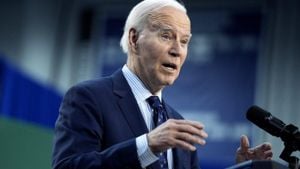Election season can bring out both wild optimism and despair, and the 2024 United States presidential election is no exception. With Donald Trump once again reclaiming the presidency, political analysts and voters alike are trying to make sense of the electoral outcomes and what they might signify for the future of American politics.
On November 6, 2024, Trump was declared victor, earning 312 Electoral Votes (EVs) and surpassing popular vote predictions as he approached 77.1 million votes against Vice President Kamala Harris’s 74.6 million. This marks another chapter for Trump, who previously claimed victory against Hillary Clinton with 304 EVs. Notably, Trump’s campaign has varied from his approach four years ago, reflecting some pivotal shifts within the American electorate.
Political analysts have speculated whether this election reflects significant changes or merely short-term candidate effects. University of Illinois political science professor Brian Gaines articulated skepticism over the notion of long-lasting shifts, noting, "I’m very wary of 'realignment' claims because they suggest stability going forward." He pointed out Trump’s gains among demographics traditionally aligned with the Democrats, including nonwhite males, but cautioned against assuming these changes signify enduring loyalty shifts.
Poll results preceding the elections have historically served as predictions, but 2024 has proven these forecasts can often miss the mark. With the advent of new polling technologies—a mixture of robocalls, online panels, and text messages—polling has faced challenges, with fewer people willing to participate. This shift makes it difficult to obtain accurate data, leading to discussions among experts about the necessity of reevaluation within polling methodologies.
Critics of polling have pointed out the inherent biases and technological limitations affecting results, with many surveys blending candid responses about intentions with previous behaviors. The nuances of polling present considerable challenges, particularly as new voting methods evolve, complicate the predictive nature of election polling. This restrictive rise makes it harder for pollsters to gauge the public's sentiments accurately.
One topic generating significant discourse following the results is the apparent disconnect between public opinion and the electoral outcomes—especially when considering past results. For example, one late-October poll predicted Vice President Harris would lead Trump 47% to 44% in Iowa, yet Trump ended up winning the state with 56% to 43%. Analysis of predictive data reflects major disparities, pointing to the complex and unpredictable nature of election campaigns.
Many observers had anticipated this election to be steered by issues such as abortion access, particularly following the overturning of Roe v. Wade by the Supreme Court. The expectation was for strong turnout among younger female voters galvanized by these changes. Yet, contrary to these predictions, Trump made significant gains among white and Hispanic women, increasing his margins from previous elections. Among voters between 45 and 64, for example, Trump garnered support from 54% compared to Harris’s 44%.
Interestingly, there were notable shifts within specific demographics. Among Catholic voters, who account for 22% of the total electorate, Trump earned 58% of their votes. The formerly Democratic dominant Hispanic demographic showed Trump gaining 27 percentage points since 2020, indicating shifts not seen as widespread since his previous candidacy.
While the focus on gender and abortion was palpable, the results prompt questions about what it means for the future of the Democratic Party. The messaging surrounding abortion and other social issues must resonate deeply with voters; otherwise, political candidates risk losing ground, as was highlighted throughout this election. Some analysts argue the Democrats might need to recalibrate their approach to family-centric issues, integrating not just concerns surrounding women's rights but also broader economic incentives to favor family formation.
Republicans have shifted their stance on the pro-life argument by repositioning the conversation about abortion away from strict restrictions to support focused on family welfare. J.D. Vance, Trump’s running mate, emphasized the need for pro-family economic policies rather than merely focusing on restrictions, aiming to engage voters on more than just legal issues linked to abortion.
This election also witnessed the significant absence of what was referred to as the anticipated “red wave” during the 2022 midterm elections. Political observers are left to ponder whether the GOP's momentum now indicates the arrival of this trend. The bifurcation of voters across state lines showcases varying regional preferences, with many states electing differing political representations across national and local positions. The complexity of these splits has generated vast discussions about voter behavior processes across diverse demographics.
Digging through the surface, one would notice similarities between the patterns exhibited during the phenomenon of split-ticket voting, as many voters appear willing to support different parties for different offices. The realignment says more about individual candidate popularity rather than party allegiance, as split-ticket voting is still prevalent. This raises questions about current electoral marketing strategies and whether the dichotomy of loyalty persists or is more malleable.
Election results often yield significant claims of importance, with the specter of realignment overshadowing discussions of local issues. Yet analysis reveals potential pitfalls when overstressing these narratives. The essence highlighting the 2024 results may ironically echo notions of repetition rather than genuine surprise. The complex murals of the electorate create contrasts, making certain predictions and interpretations of results overly simplistic.
Viewing the overall dynamics showcased by the 2024 election leads to speculation about the potential future of both major parties engaged within the shifting American electoral tide. The Republicans have exhibited considerable gains among demographics believed previously solidly aligned with the Democrats, hinting at significant changes manifested within voter sentiment. Could these shifts indicate budding discontent with existing policies or merely reflections of candidates' popularity?
Backwards glances reveal just how complex this narrative is. High-stake games of politics often play out against many factors, including voter dissatisfaction and shifting demographics. The results of this election continue to reflect divisions across political, social, and economic lines. These lines may blur, yet the results foil attempts to generalize what the future holds and which voices resonate within the fabric of American democracy.
Though Democrats may be left wondering how their messaging failed to resonate with core demographics, Trump’s victory appears supported by traditional bases intertwined with new voter coalitions. The reality remains layered and multifaceted, pushing both parties to rethink approaches not just for the immediate future but for the broader dynamics of American politics. China is watching closely as this economic embodiment of American power grows increasingly unpredictable; what remains undisputed is the importance of these electoral results shaping the future discourse.
Reflecting on the election means grappling with elephants and quirks lining the political room, each ripe for discussion and analysis. The task is equal parts responsibility and challenge, pushing analysts to unpack the clues laid out on voting ballots. The juxtaposition of uncertain recovery and resolve signals perhaps we haven't seen the last of Trump, as he will undoubtedly remain at the center of political discourse, shaping conversations with historical ramifications.
Will the tide turn on conversations surrounding family-centric issues, and will Biden-Harris's failures echo louder? The intricacies of democracy will continue playing out as newer candidates and ideas emerge, and shifts remain confident and sure-footed amid shifting allegiances.



